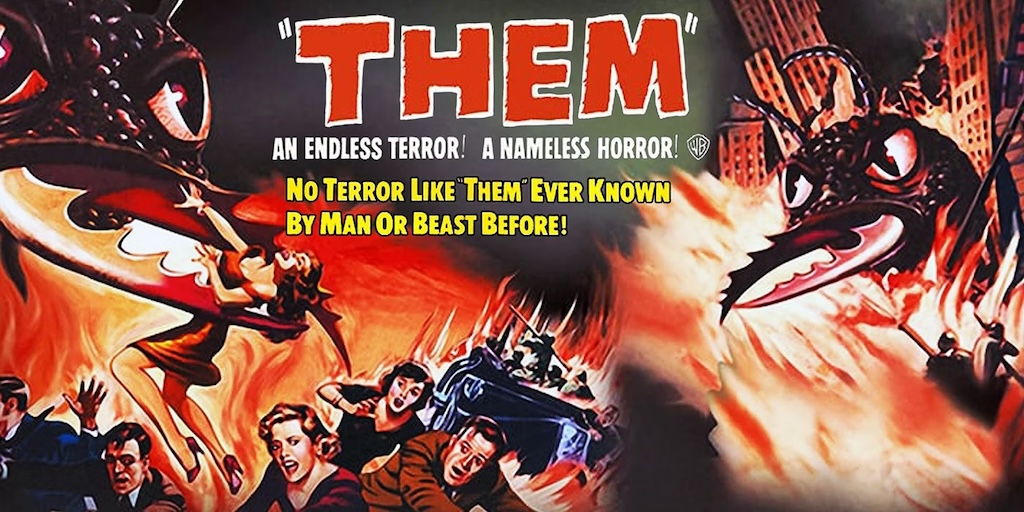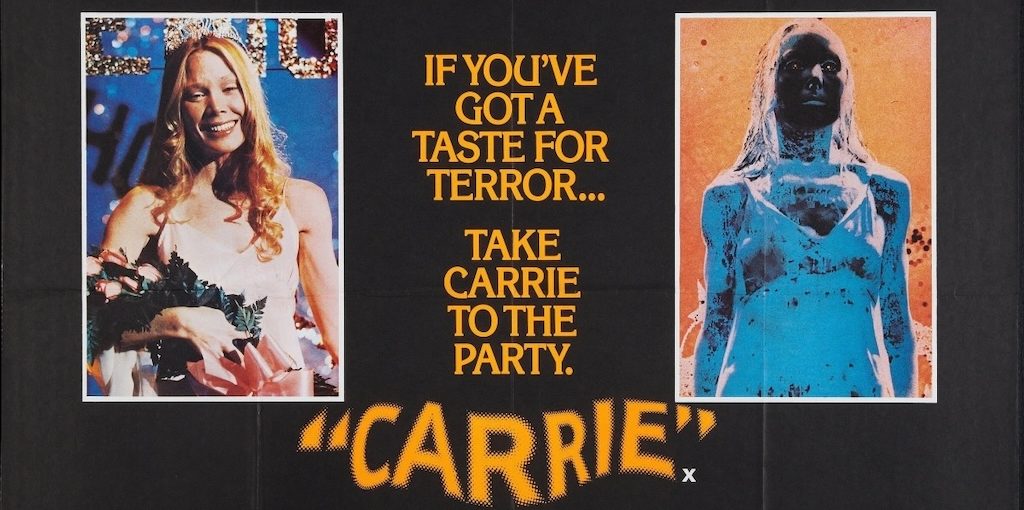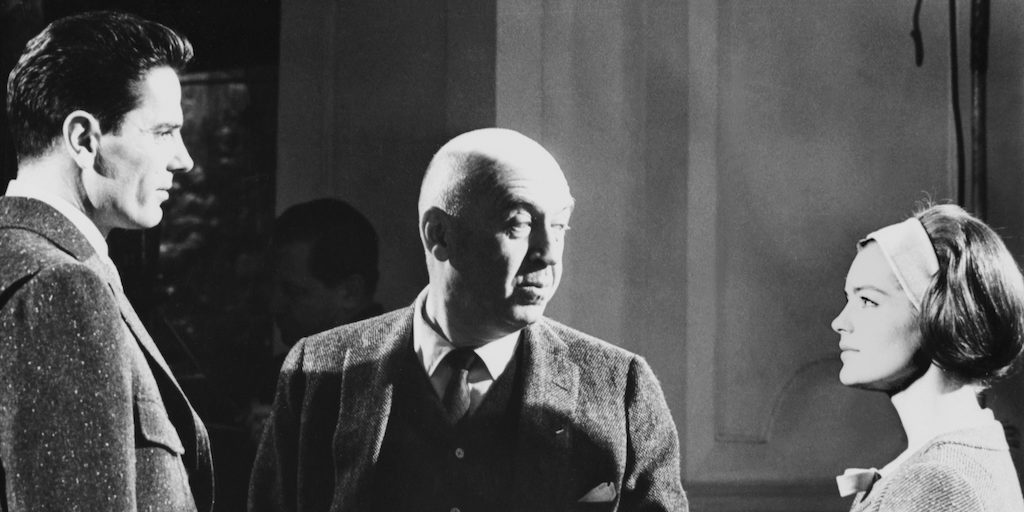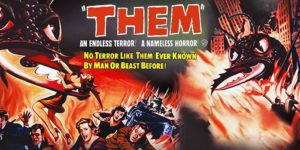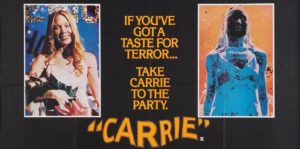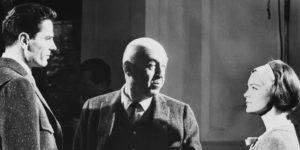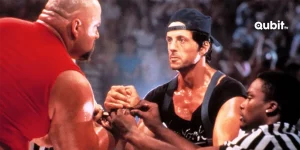For Diego Ávalos
Next to what we denominate film auteurs central to the display of classic American cinema, both in its first as in its second articulation (Hitchcock, Hawks and Minnelli), we are introduced to John Ford. Which it has to be explained as follows.
Our position about the central triad above mentioned plays in and within the terrain of one of the main thesis of these studies: the cyclical recurrence ––in a Vichian sense–– of the three stages as proposed by the author of the NEW SCIENCE and his corresponding reappearance and refraction in Hollywood Classical Cinema; but within this cinema the author that represents centrality within a determined territoriality is John Ford.
By this we mean as follows. First: the transition from the English period to the American period serves of use to Hitchcock to universalize his cinema, which is to achieve that ecumenical position, fundamental to his purpose as auteur-theologist (1).
Second: Hawks is occasionally co-participant of the Fordian relieving of territoriality, in films such as Sergeant York or Red River. But they are launching platforms, support points leading to an ecumenical centrality evident in his major works, such as Bringing Up Baby, Only Angels Have Wings, Rio Bravo and Man’s Favorite Sport?, among others. In these films is evident how Hawks universalizes, that is he turns ecumenical themes and structures of his most local ––even “provincial”–– films (such is the exemplary negative case of Sergeant York). As a heroic auteur, Hawks must first create an atmosphere of territoriality to launch himself a posteriori to a totalizing epicness where that which is local is just an element within a larger structure.
Third: Minnelli, in his search of giving central meaning to that which is lateral, must first go through the “temptation” of becoming culture’s great master of ceremonies, a host to the shipwreck of a decadent and abolished world, and should he have followed in the footsteps ––already concluded, on the other hand–– of Von Sternberg and Ophuls’ works (2), it would have turned him into only an epigonal auteur.
Since Minnelli overcomes such an instance in two films of visible and transparent ecumenical ambition (Madam Bovary and Lust for Life), he manages to strategically withdraw with his potentialities intact to undertake works of a very complex impenetrability such as, for example, Some Came Running or The Four Horsemen of the Apocalypse. The auteur-human that is Minnelli had to purge himself in the initiation waters of the great adaptation (Madame Bovary) and of the “great themes” (Van Gogh in Lust for Life) to surf once again the current and arrive in such a way to the state and stage of a “Cheerful Goya”, reaching a level of self-awareness that he always coveted (3).
John Ford never set his mind on ecumenical ambitions, choosing instead to materialize into an exemplary territoriality. Hence the “tardy” and sometimes problematically ambiguous acknowledgement harvested by some of the pioneering critics regarding the vindication of Hollywood Classical Cinema, launched by scholars eccentric to that country; and how, in parallel, was comprehended without any problems by the top critics of that country (Andrew Sarris and Peter Bogdanovich).
It is obvious as well how the eccentric criticism was able to grasp ––even intuitively–– what is particular and notable of that cinema by more frankly universal auteurs. Hitchcock and Hawks did not present any “recognition” problems beforehand, since they inserted themselves into a cemented or visible universality.
If Minnelli did not enjoy this immediate critical privilege, it was because in his condition of post-Welles baroque auteur he seemed to some European scholars as a relevant epiphenomenon adjunct to the self-conscious display that came from Citizen Kane.
Minnelli was dour and inapprehensible enough to those first critical-intuitive forays that could not contemporarily assimilate the radical aesthetical revolution by this auteur, mistaking him for a decorator or set designer, in the theatrical-musical sense of the word. But his posterior recognition was possible precisely because Minnelli’s films kept no more than a contingency relationship to the American territoriality, a contingency which, by flowing parallel to a marked ironic relationship to the diegetic universe of his films, achieved the necessary ––by this we mean enough–– access to his insides or his private sphere (4).
There’s a something ambiguously uncomfortable in John Ford’s body of work. Some exegetes and dilettantes have ended up accepting him, even reluctantly, for the “dimension” ––even in the academic sense–– of his works. But there is always a remainder, a detritus, a bad aftertaste from some of his improvised apologists. That remainder is, in our terms, provoked by the absolute yet tenacious Fordian decisionism. Decision and John Ford are non-exclusive terms. As a decision it is fatally History; the European amateur tried to overlook his military parades, his ordered convoys driven by pioneers and the “submissive” wives and mothers that waited, domestically, the return of the warrior.
The autonomous epicness of heroes in Walsh or Hawks’ films, for example, did not present ––it is fair to acknowledge–– such assimilation problems. Always at the bend of the road of the living, the protagonists in such auteurs’ films have a necessary ––and indispensable–– time to submerge into their private spheres, a thing that Ford’s heroes seem to be deprived of.
There is nothing more unthinkable than Rio Bravo directed by John Ford. The long “existential” disquisitions of Hawksian professionals are unimaginable in Stagecoach’s auteur. On the other hand, there is not a scale of values between professionals and amateurs in Ford’s body of work. For this auteur the difference between men is not a measurable category of professionality or amateurism, but a decisionist acceptance of an ethical mandate that cannot graze even the private sphere.
Tyrone Power in The Long Grey Line or John Wayne in The Wings of Eagles allow the private sphere to pass by ––and run out–– to the side of life, and when they attempt to recover it, it turns impossible given that they have pawned their human display for a higher sphere.
The Fordian hero is one that goes through the display of the epic as a territorial story, and when finally must delve into that same territoriality to shelter into the domestic sphere of a territoriality that he himself has contributed to build and cement, the visible building, in its historical materiality, shuts the door in his face (5). John Wayne in She Wore a Yellow Ribbon, The Searchers, and ––exemplary emphasized–– The Man who Shot Liberty Valance is left without nothing, except turning himself into a myth or a support to the mythical, which is to be a legend…
If anything turns John Ford’s cinema into something complex, almost intangible, is his Balzac-like skill to go through multiple metamorphosis. The John Wayne of Stagecoach is not the same than in the three films above mentioned; the same way he is not ––though for different motives–– that of The Quiet Man. Because, like in Walsh, there is a lot of faces or facets to John Ford’s work.
Territoriality as history. It is the most visible, canonical or canonized Ford; it is also the most uncomfortably “classic”; he who is accepted between coughs and nervous interjections of all kind; he who is accepted for being an academic, a decorated Navy man, the great official American director, the director of documentaries during World War II, but also in Korea and even in Vietnam. The frugal, grouchy, patriarchal Irishman that thanks ––with great praise–– the country that took in his elders and his fellow countrymen. All this is true, as in that Ford never shied away from such responsibilities.
But it is also this Ford the auteur of films such as Stagecoach, They Were Expendable, My Darling Clementine, Fort Apache, She Wore a Yellow Ribbon and a long and fortunate etcetera.
Is that who asks, responsibly, for that in which consists the fundamental demand for being territorial: How did we arrived, conquered and lived in this place…
In the films participating of this current of territoriality as history, the hero is not a professional seeking his self-esteem (like in Hawks), but rather the fatal instrument of a History that uses it as the subject of a superior course of action. If all contact to the historical is problematic in the measure that every new structure runs the risk of setting back the subjects he uses for his purposes to a prior state of consciousness, Ford’s heroes seem to achieve some sort of truce between historical evolution and free will, as transparently is the case, for example, with the confrontation between Henry Fonda and John Wayne in Fort Apache. Though both sides “have their reasons”, the audience must formulate or reformulate their reasons in a temporality where the present is the access via regia to the historical turned mythical by the epic structure. Since the question on which western metaphysics is based upon is that of “Why there is something instead of nothing?” The medium-like translation of a question from our temporality that turns an emerging materiality as a vague otherness is just the vicious circle of a grotesque irresponsibility; although certain contemporary anthropologies, with few exceptions, have lent themselves to that, all in which, if we scratch the varnish that shallowly covers them just a little, we can always find Nietzsche disguised as a Viking.
The history as territoriality. This zone of the Fordian body of work can be denominated as Ford’s “Irish period”. Comprised of much known films such as The Informer or The Quiet Man, as well as films not much frequented such as The Plough and the Stars and, especially, that absolute masterpiece that is The Last Hurrah, one of the first testaments of this auteur.
If in The Informer or The Plough and the Stars we have the contemporary fight of the Irishmen for their freedom, if in The Quiet Man we have the homecoming to an Ireland of ideal perfection where the myth is larger than history, then, in The Last Hurrah we see how the Irish community in America has managed to live and survive in their own terms. This film, which must be seen in rigorous symmetry to the Corleone saga by that other Ford: Coppola, is ––after the fight in history and the recovery in the mythical of that which is Irish–– the refraction-excision of Irish territoriality within American History. That old politician-chieftain of Irish origin (Spencer Tracy) that handled himself with shady deals, but has attempted to maintain tradition in his own terms, finds himself displaced by a modern liberal newcomer (an ostensible carbon copy of the back then senator John F. Kennedy) who gains the support of the new community of voters and the episcopal blessing of the ecclesiastical authority that needs to update in their own terms.
Shot in 1959, The Last Hurrah makes a precise pendant with the almost contemporary The Leopard by Luchino Visconti (1962); being both currents taken to the last stages of self-consciousness, decisive by Ford Coppola’s Corleone Saga. All these films that must be seen corresponding to their hermeneutic analogy to comprehend ––or even hint at–– our times (6).
Men without Women. If Ford never took or attempted to take, for all we know, any text by Hemingway is because both set themselves, although by different methods, to do the same thing, at least in a tangential sector of their bodies of work. The male autonomy, or the temptation of male autonomy, are in John Ford very different to how it is manifested in Howard Hawks’ body of work. If in this auteur the presence of the female is an absolute form of the otherness, in Ford is the full acknowledgement of family as a legitimizing institution of territoriality, but it is also conservative when it comes to the hero’s private sphere that, in his historical making, can run the risk of forgetting about the continuity of the species. Said continuity is not just biological as in Hawks ––where the symmetrical risk is the female speciousness––, but it is biological-transcendent. In Ford marriage and therefore family are contracts that legitimize the belonging to a territoriality, or better said: in Ford’s cinema men are those in charge with sustaining the territoriality and women are in charge with inserting that territoriality into an ecumene. There lies the problem of a contemporary female insight anchored in a militant speciousness about the role of women in films by this auteur. We can think of the following analogy: such an insight would be like if Katherine Hepburn in Bringing Up Baby, or even Angie Dickinson in Rio Bravo tried to make a criticism on John Ford’s female characters…
That is because these figures are post-feminist, and Fordian females do not have to question their own situation, since they are boxed into a specific historical moment.
In this zone of the Fordian body of work are inserted films such as The Long Voyage Home, Donovan’s Reef, Two Rode Together and, laterally, My Darling Clementine, where this motive is resolved ––rather problematically–– towards the end.
From this current also participate extreme works of this tendency such as The Lost Patrol or The Prisoner of Shark Island.
Among Lone Women. Exemplary as it is in his last film and another of his testaments: 7 Women, but also an earlier and less frequented film as it is his Mary of Scotland. Both about woman-in-history and without men (7) arriving to sainthood. With an exemplary coherence in a three decade hiatus, both films conform a duet: the former follows the trajectory of a saintly-historic-woman, and the latter follows a fictional unknown, who without the same ostensible militant faith as Mary Stuart, reaches the same status; the same way as with Dreyer’s Joan of Arc leading to his final film, Gertrud. A perfect example, on the other hand, of what we call in these studies the ecumenical will of cinema.
The imaginary autobiography: four emblem-characters and a private ironical quote. A military instructor in The Long Gray Line; a sailor-writer in The Wings of Eagles; a political chieftain in The Last Hurrah, and a gunslinger in The Man who Shot Liberty Valance. All four films conform an analogic autobiography of John Ford’s career as a filmic auteur. The first instructs soldiers participating in wars the hero is unable to participate in, because he is needed back home. The sailor-inventor that in an interregnum of his life discovers his call as a playwright and screenwriter. The old chieftain defeated by a young liberal politician more up-to-date with what the Irish-American community needs. Finally, the gunslinger that “anonymously” kills the dreadful Liberty Valance, but allows the “idealist” lawyer, who brings progress and the law of the books, to take the credit, as well as allowing him to keep the woman with whom he would have settled down.
All four are mirror images of John Ford, who orderly and cyclically confesses his disappointment with the America he contributed to found and organize, as a teacher, as a fiction maker amidst history, as an emblem of his community of origin and, finally, as a coiner of mythologemes.
There is a long line of caravans that bid farewell or march into the unknown in Ford’s final films. Parades or marches that leave the protagonists to the side of the road; doors that close, tired salutes, weary and late-sounding farewell waltzes. Old pioneers that do not bow down to take a perpetual vacation or sit behind a desk; Irishmen still thirsty enough to go into adventures the contemporary world believes to be impossible.
In the same way, that John Ford loaded with official honors, does not bow down to be instructor of inexperienced youngsters who ––maybe–– salute him, paying him the ambiguous tribute of master of a time gone by. From there, the private ironical quote in The Wings of Eagles. When the protagonist takes his stage play to adapt it for the screen he encounters with an “old director” in an office lined with American Flags, firearms, Oscar statuettes and hunting trophies (which the Oscars are as well).
That old filmmaker that secretly drinks (and even uses his walking cane as a disguised flask) is an imaginary John Ford, prisoner of his fame and his legend (8). A John Ford installed in his Chester chair, taking a nap under an Indian blanket, dreaming of adventures that still await him beyond this bungalow-office, behind the trimmed hedges and the geometrical flower beds that circle his dubious ivory tower; who will not settle to shoot “another damn action picture” when the real action is still found ––and maybe–– beyond the river and among the trees.
The three final testaments. Abandoning the comfortable and ambiguous sanctuary of his consecration ––even glorification–– in life, Ford prepared three final testament-films. Cheyenne Autumn, Young Cassidy and 7 Women. This trilogy serves as well as a point of refraction (10) of the whole Fordian body of work, and it is an example ––we believe unique–– in all modernity’s art. We will never know Doctor Bovary’s point of view on Emma; we will have to settle to never know how Marcel was seen by the dozens and dozens of characters as analyzed by the narrator from In Search for Lost Time; we will never enter with K, the alleged surveyor, to the alleged castle, and even less we will have a description of its insides. But we will know how the Indians saw how the West was conquered, how an Irish young man dreamt of being John Ford before he ever was (and knowing that he knew) and how seven women are known in a film directed by this “director of men”.
The reviling against the three proposed films can complete an entire archive (11); only a few critics contemporary to their releases managed to glimpse the greatness and exceptionality of these films. But rushed by a ––comprehensible, on the other hand–– guerrilla war against such run-of-the-mill journalism, they sacrificed their apologetic argumentations, over jumping the necessary ––for his rumination and meditation–– comprehension of such films.
It was not about “asceticism”, “economy of means” (whatever this means); neither it was about the “old master that intones a nostalgic farewell to his characters, etc.” It was, like in the last films of Hitchcock, Hawks, Walsh, Minnelli, et al. about a last articulation of the classic moment; that which, by refracting in a perfection that can only be described ––summarily–– as the “soul of forms”, fights to become history, to be world; that abolishes in its making all those things it does not need in their operation, and in that exhaustion assimilates that which it feeds upon and sheds away the superfluous: because it has already been devoured, digested and even excreted beforehand; a beforehand which the newcomer “judges” as pure actuality.
In this trilogy, Ford (as Hitchcock in Marnie and Hawks in Man’s Favorite Sport) achieves to shed away even the slightest necessity for contingency: be it as history, be it as set design, be it as performance. Like those works dreamt by the erratic genius of the also Irish W.B. Yeats in the final stage of his creation. Works that with minimal elements would participate of the auto sacramental, of the Japanese Noh and the plain iconicity of the medieval emblematic of the illuminated Celtic missals, but that barely could express, except as poetry.
The Irishman in exile that John Ford was did achieve that synthetical form that covers all the prior in sum of parts that gradually abolishes the margins in every series of things of which he feeds in his making. So, the art reconquers its belonging to the rite, of which always felt nostalgia in modernity, and whose cyclical attempts of re-approximation dye the most valuable within the contemporary making; so, cinema also achieved ––in a rather finishing touch, as we sustain–– that propriety of rite; and if Ireland has in those displays a central function ––almost providential–– it was not, as we say, Yeats’ erratic genius or Joyce’s ecumenical genius, that achieved to make it; but the serene genius of John Ford that travelled a lot farther than the author of Ulysses, so far that he progressively lost his sight; and that final blindness ––as Homer’s mythical–– lands in the most absolute light.
Once ––many years ago–– I attended a lecture at UBA School of Philosophy and Letters. There, a celebrated Argentinian Hellenist exaggerated with his supposed hermeneutic about the unarmed removal of Homer. He conducted the lecture in such a way that his students (most of which expected the end of the lecture to either go to a discotheque or a group therapy session) found themselves facing such situation: the author of the ILLIAD had a bias towards presenting the Greeks as beautiful, blonde, noble and brave, and the Trojans as dark, vile and coward. He even made an analogy with Argentine history that I will not transcript here because, as Valéry said, stupidity is not my strongest suit. He insisted in proving that the ILLIAD was, somehow, an “American Western” where the Hellenes were Cowboys and the Trojans were the Indians.
Even though I mentally remembered that “in the mouth of the stubborn the truth is listened” I was not satisfied by such a comfort of the “popular” wisdom and then ––youth is always impulsive–– I asked why we didn’t ask the myth. I reminded him that the War at Troy took place because three goddesses from the Olympus had chosen, as judge to their beauty, the most handsome of all men, the Trojan Paris; a thing Homer did not deny or swipe off. Therefore, his lecture of the ILLIAD was fallacious since Homer also showed Paris’ brother, Hector, as noble and brave, etc., etc.
In a rapture of retrospective lucidity the laureate local Hellenist said we were right, to immediately insist with his demagogical hermeneutics. I do not know if he ever got to talk about the Greek “militarism” since we swiftly left the premises which, luckily, were in the vicinity of the cinematheque, where that afternoon was projecting Stagecoach.
As the reader may remember, in that film there is a scene where the precarious stagecoach that fronts the title is left without a driver. The community traveling in it has their differences translated as prejudices. The virtuous wife to the high ranking military officer disdains the contact with the “fallen woman”; the ruined southern aristocrat courteously approaches the former discovering her humble origins; the banker who fled with the money of his clients and speaks ill of the disorganization of the Army that does not protect the honest taxpayers; a good man prays; another one fights as best as he can against the Indians under his customary drunkenness… A gunshot from the attackers has left the stagecoach’s driver defenseless; the reins jump and twist chaotically among the legs of the horses, galloping at full speed (them too, in their own way, fight for their lives); it is then when the hero named Ringo (John Wayne) throws himself over the horses to take the reins of the stagecoach.
“There are a thousand ways to frame a scene, but only one is the right one” said Ford when he was in the mood to explain himself. It is true: but only that way is the right way when all that which is out of the frame governs what we see.
I remember that in that moment I also thought of the following and I want to remember it here. Any prudish professor can say all the childish things he wants to a motionless mass of quasi adolescents; he can destroy Homer, he can make him say anything about any subject, because neither that “educator” nor those students decide anything. They are just part of the great concentrated assembly line of modernity that keeps them calm and conformed, simulating that they dedicate their time to something “superior”, scholar and fundamental; not contaminated by the dust of the crass day-to-day life that rises undaunted just a few feet from where an eternal deliberative colloquium is rushed into motion.
It is fit to one and the others to lend themselves to this sterile eagerness, because like the hapless loves, they deserve each other. But if you have the possibility to see for a moment and for all eternity John Wayne throwing himself over the rampant horses of a stagecoach at full speed to regain control of the reins, then you can know that Homer is still alive, present, and not in the dusty binders full of weak papers that do not mean anything, but in the pure truth of John Ford’s cinema; where heroism is still and always possible and not an ostentatious, laughable and moldy mutter of unhabitable philology.
*Essay contained in “Mito, Método y Recurso. Prolegomena a una teoría del cine” (unpublished)
- See at this level the two versions of The Man Who Knew too Much.
- In the case of this auteur, not necessarily conclusive, but it is when referred to his passage through American cinema.
- See The Cobweb (1955)
- It is notorious how the cinema of Frank Tashlin and Jerry Lewis became easily recognizable in Europe, given their apparent extreme irony about the American diegetics; and how, symmetrically, these works do not enjoy any recognition from the American Critics (Andrew Sarris, for example)
- An image taken inversely and symmetrically in the ending of Coppola’s The Godfather, where Michael Corleone’s wife is left outside her husband’s world.
- This can be taken as a personal effusiveness; you can also try and see these films in the manner they are proposed.
- Not so much “without men” in the case of Mary Stuart, at least in the historical-biographical sense.
- The Wings of Eagles, as you might remember, is based on the life of Frank “Spig” Wead and his stage play, Ceiling Zero, was adapted for the screen by Wead himself and directed in 1935 by Howard Hawks. As we can see, here we have another element or hermeneutical clue that could be tracked back or be read properly someplace else.
- This film was finished ––when Ford fell sick–– by cinematographer Jack Cardiff, who also signed the credits, but the conception, the framings and the vast majority of the shoot were proven to be on Ford’s account. In some filmographies Ford’s name already figures in the main titles.
- The most elemental definition for refraction is: a change in the direction of light by going from one point to the other.
- Not just the journalistic reviews of such films, but of The Man who Shot Liberty Valance as well, nowadays praised by even the most elemental gossipers and data gatherers in America.



